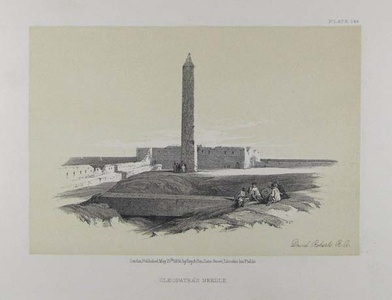| Method | Lithograph with tint stone |
| Artist | after David Roberts |
| Published | London, Published May 15th. 1856, by Day & Son, Gate Street, Lincoln's Inn Fields |
| Dimensions | Image 123 x 177 mm, Sheet 202 x 285 mm |
| Notes |
Plate 146 from Volume 4 of the small format reprint of Roberts' The Holy Land, Syria, Idumea, Arabia, Egypt & Nubia. A view of 'Cleopatra's Needle' at Alexandria, Egypt. The so-called 'needle' was one of a pair of red-granite obelisks set up in the city of Heliopolis during the reign of Tuthmoses III. In the late first century BC, the pair were moved to Alexandria to adorn the Roman-era Caesareum. In the nineteenth century, both obelisks were gifted to foreign powers and removed. The fallen obelisk, depicted here partially excavated, was given to the United Kingdom in 1819 by the Egyptian khedive, Muhammad Ali Pasha, at the suggestion of the famous explorer and engineer, Giovanni Belzoni. Despite the gesture, concerns over the cost and difficulty of transporting the obelisk meant that it was not removed from Alexandria until 1877. Upon arrival in London, it was installed on the Embankment. The standing obelisk was given to the United States of America in 1877, arriving in New York in 1881, when it was erected in Central Park. Roberts' view shows the two obelisks still in situ in Alexandria, within a courtyard surrounded by partly ruinous fortifications. A group of Alexandrians rest nearby each monument. David Roberts RA (24th October 1796 – 25th November 1864) was a Scottish painter. He is especially known for a prolific series of detailed prints of Egypt and the Near East produced during the 1840s from sketches made during long tours of the region (1838-1840). This work, and his large oil paintings of similar subjects, made him a prominent Orientalist painter. He was elected as a Royal Academician in 1841. The firm of Day & Haghe was one of the most prominent lithographic companies of the nineteenth-century. They were also amongst the foremost pioneers in the evolution of chromolithography. The firm was established in 1823 by William Day, but did not trade under the moniker of Day & Haghe until the arrival of Louis Haghe in 1831. In 1838, Day & Haghe were appointed as Lithographers to the Queen. However, and perhaps owing to the fact that there was never a formal partnership between the two, Haghe left the firm in the 1850's to devote himself to watercolour painting. The firm continued as Day & Son under the guidance of William Day the younger (1823 - 1906) but, as a result of a scandal involving Lajos Kossuth, was forced into liquidation in 1867. Vincent Brookes bought the company in the same year, and would produce the caricatures for Gibson Bowles' Vanity Fair magazine, as well as the illustrations for Cassells's Poultry Book, amongst other commissions. Condition: Light foxing to margins, not affecting image. |
| Framing | unmounted |
| Price | £30.00 |
| Stock ID | 39097 |

